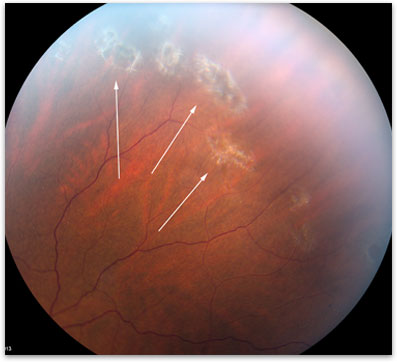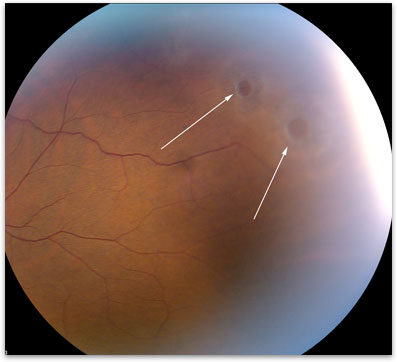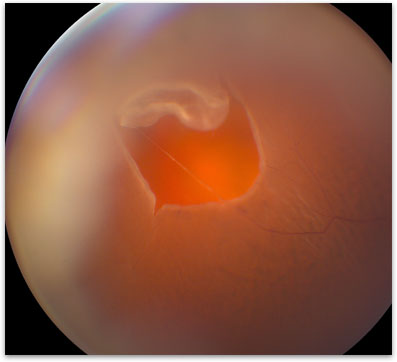Lattice Degeneration
What is Lattice Degeneration?
The retina is the layer of specialized nerve tissue lining the back of the eye that allows you to see. Typically, we only use a small portion of the center of the retina to do most of our seeing. In some people, the far peripheral retina that is responsible for our extreme side vision can degenerate and become very thin and weak. The most common form of this peripheral retinal degeneration is lattice degeneration (figure 1). Lattice degeneration is seen in about 1 out of every 10 people in the general population. When it occurs, it is common for the condition to be found in both eyes. Lattice degeneration also commonly leads to the development of retinal holes (figure 2).
What causes Lattice Degeneration?
The cause is unknown but it is more common in people who are near-sighted (myopic) and tends to run in families.
Why should I care about Lattice Degeneration?
Lattice degeneration can increase your risk of developing a retinal detachment. Although rare, a retinal detachment is a very serious problem that can lead to permanent vision loss and blindness. The retinal thinning, weakening and development of holes associated with lattice degeneration creates areas that are more prone to cause a retinal detachment. About one third of all retinal detachments are associated with lattice degeneration. Overall the lifetime risk of a retinal detachment in people with lattice degeneration is about 1 percent.
What are the symptoms of Lattice Degeneration?
Usually there are no symptoms associated with Lattice Degeneration. Symptoms typically only occur when a complication from the lattice degeneration occurs, such as a tear or detachment of the retina (figure 3). If you ever have the onset of flashing lights, new floaters or a loss of the side vision you need a prompt examination to rule out any serious problems with the retina.
How can lattice degeneration be treated?
In some cases laser treatment is used to seal the lattice degeneration and associated retinal holes. Laser treatment is a simple procedure that can be completed in the office. Laser is not effective in preventing retinal detachment in patients who have no symptoms. Therefore prophylactic treatment for all lattice degeneration is not useful.
Does Lattice Degeneration need to be treated?
For the vast majority of people with lattice degeneration no treatment is ever needed. The risk of developing a retinal detachment is very low, only around 1 percent. Even for people who develop retinal holes from the lattice degeneration the risk of a retinal detachment is only around 2 percent. However, there are some situations where laser treatment is recommended. Treatment is recommended when a retinal tear occurs, if the other eye has had a retinal detachment or if there is a strong family history of retinal detachments.

Figure 1. Lattice degeneration in the peripheral retina (arrows).

Figure 2. Retinal holes associated with lattice degeneration (arrows).

Figure 3. Retinal Tear.

